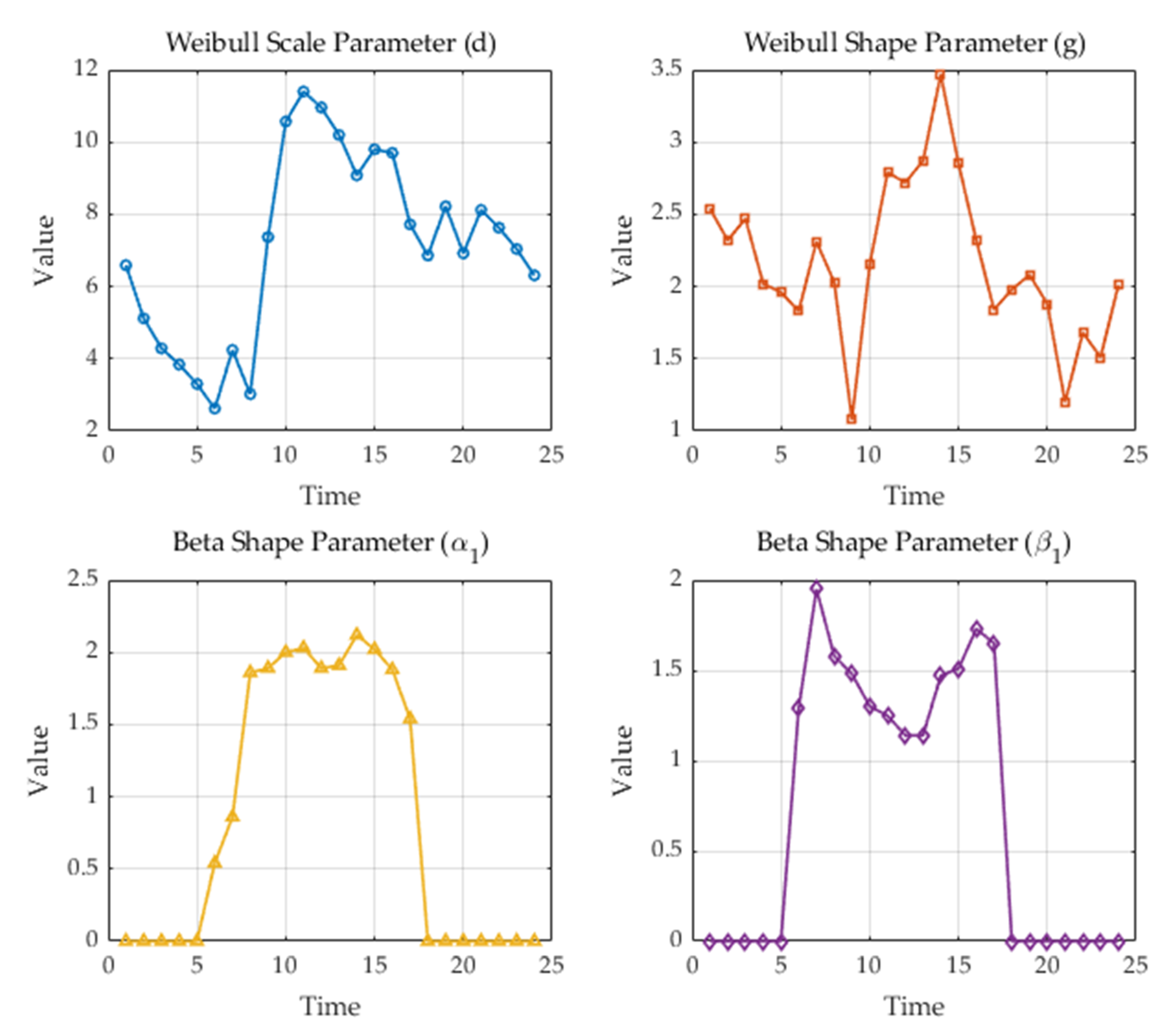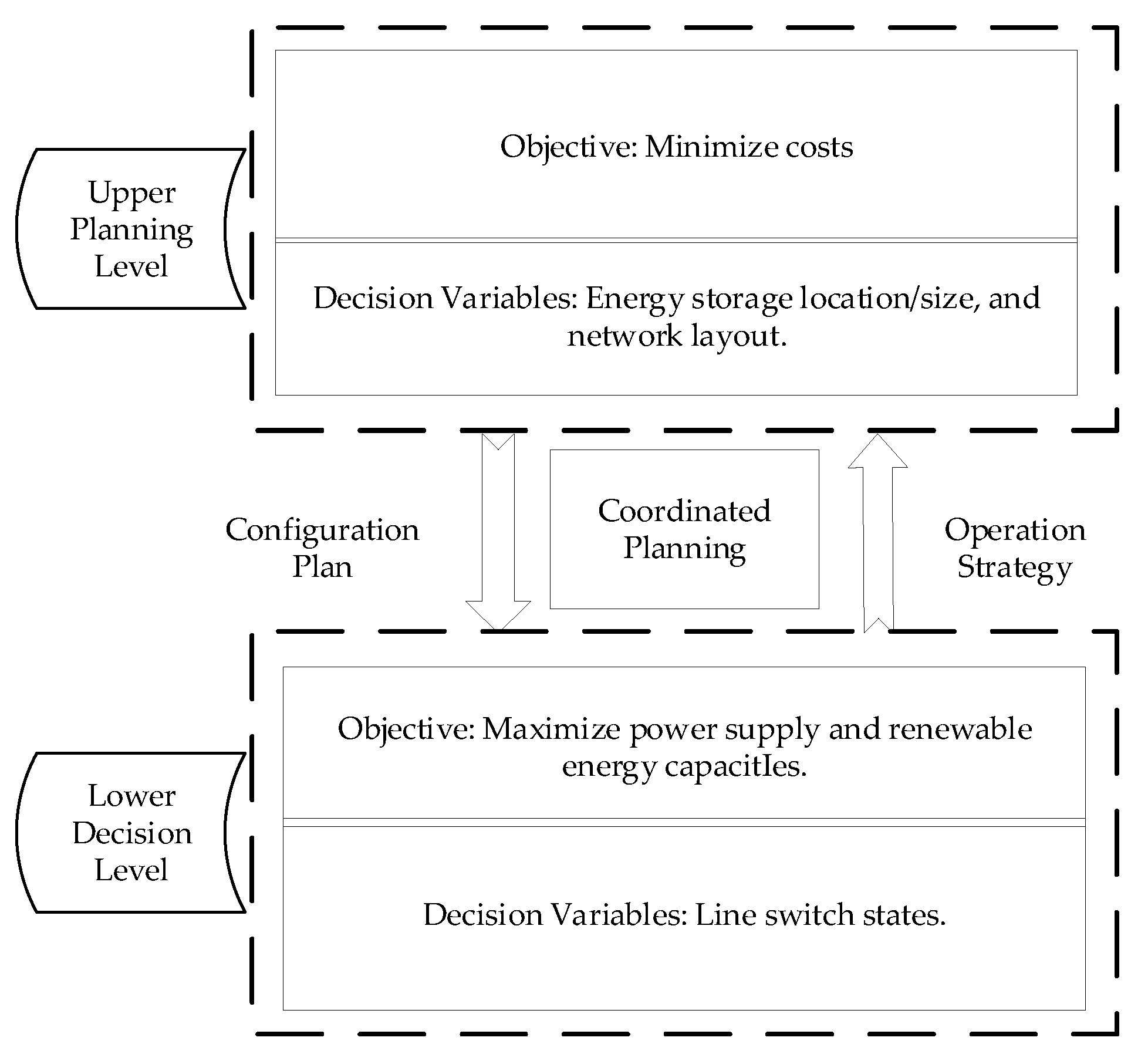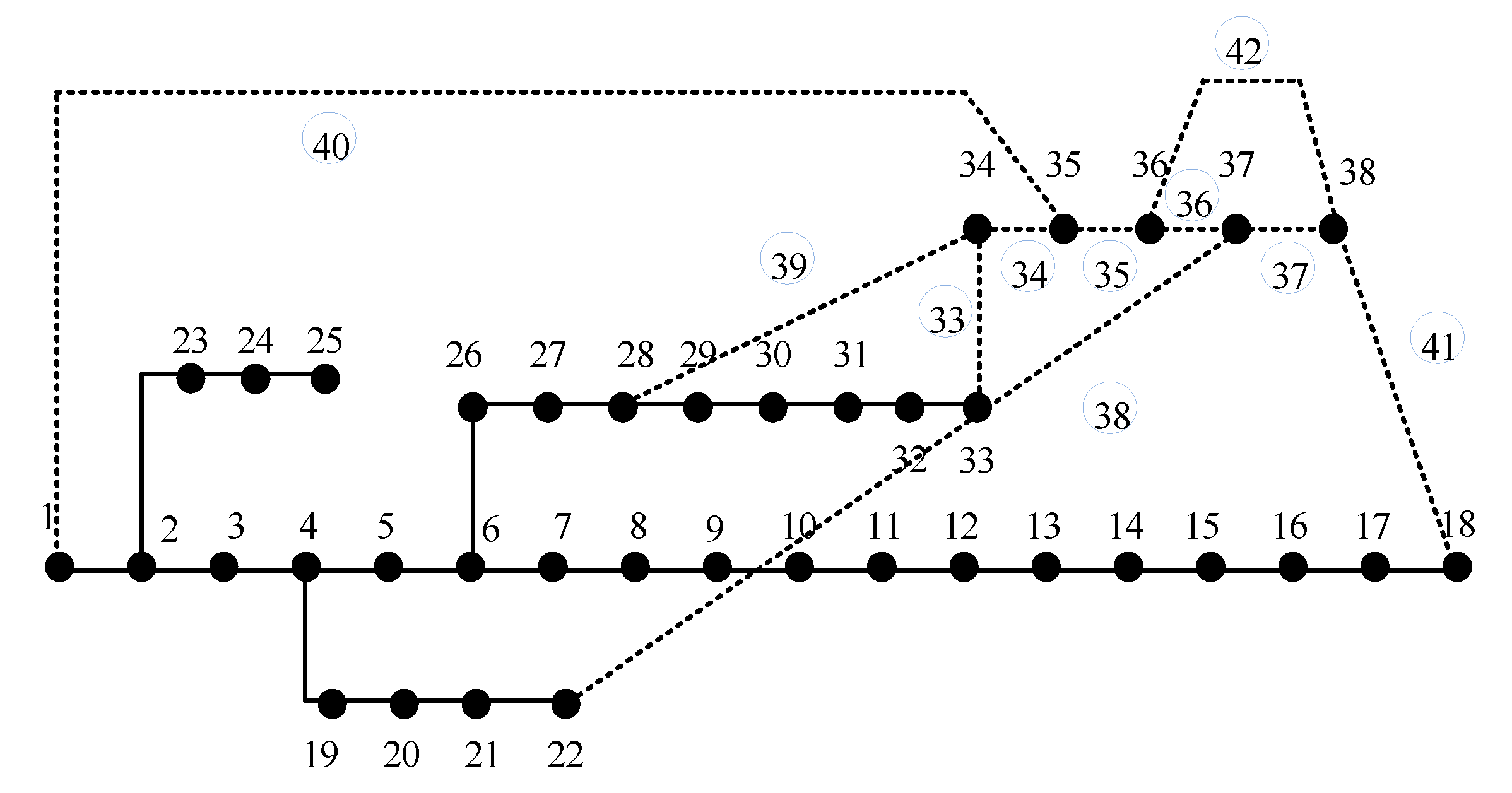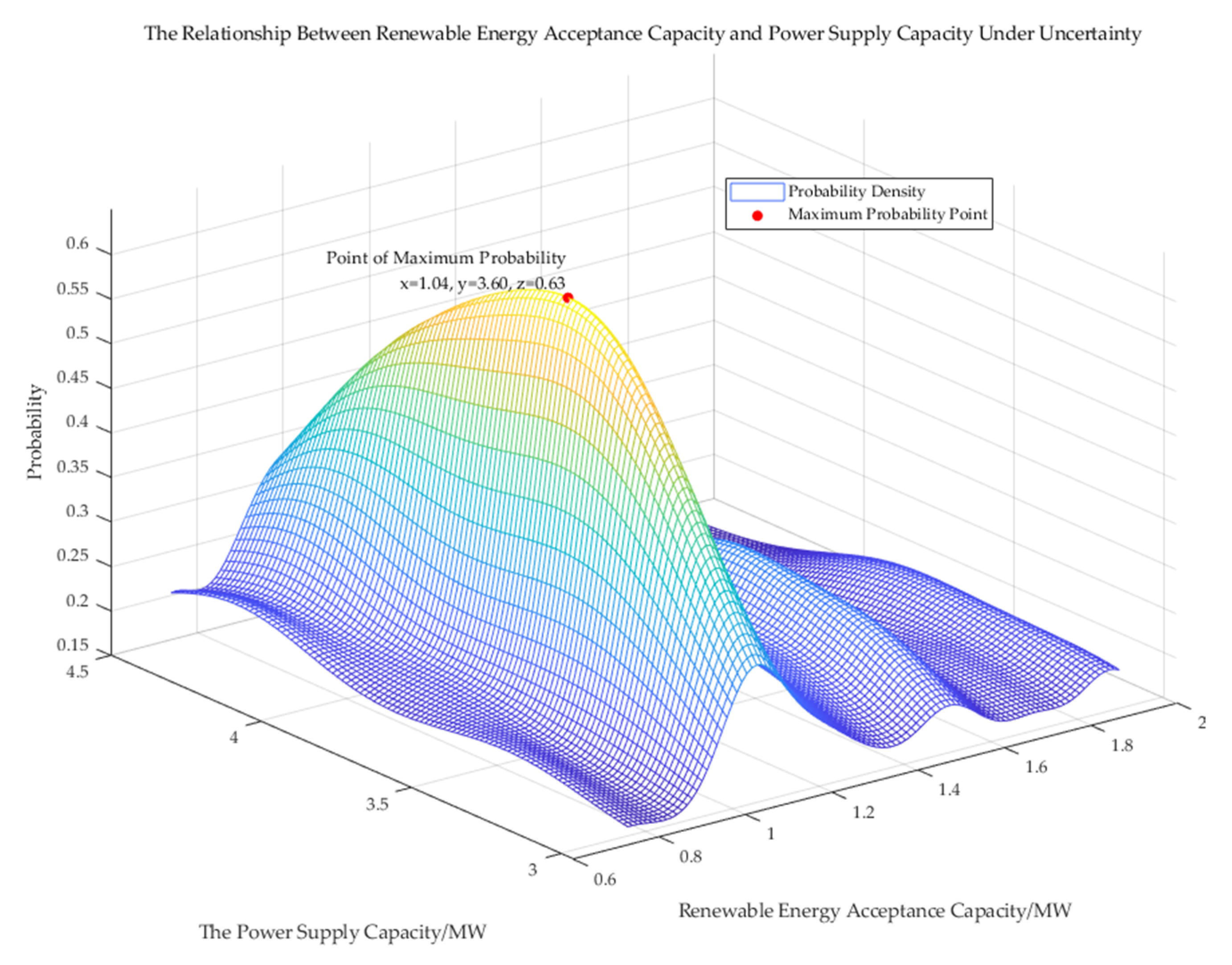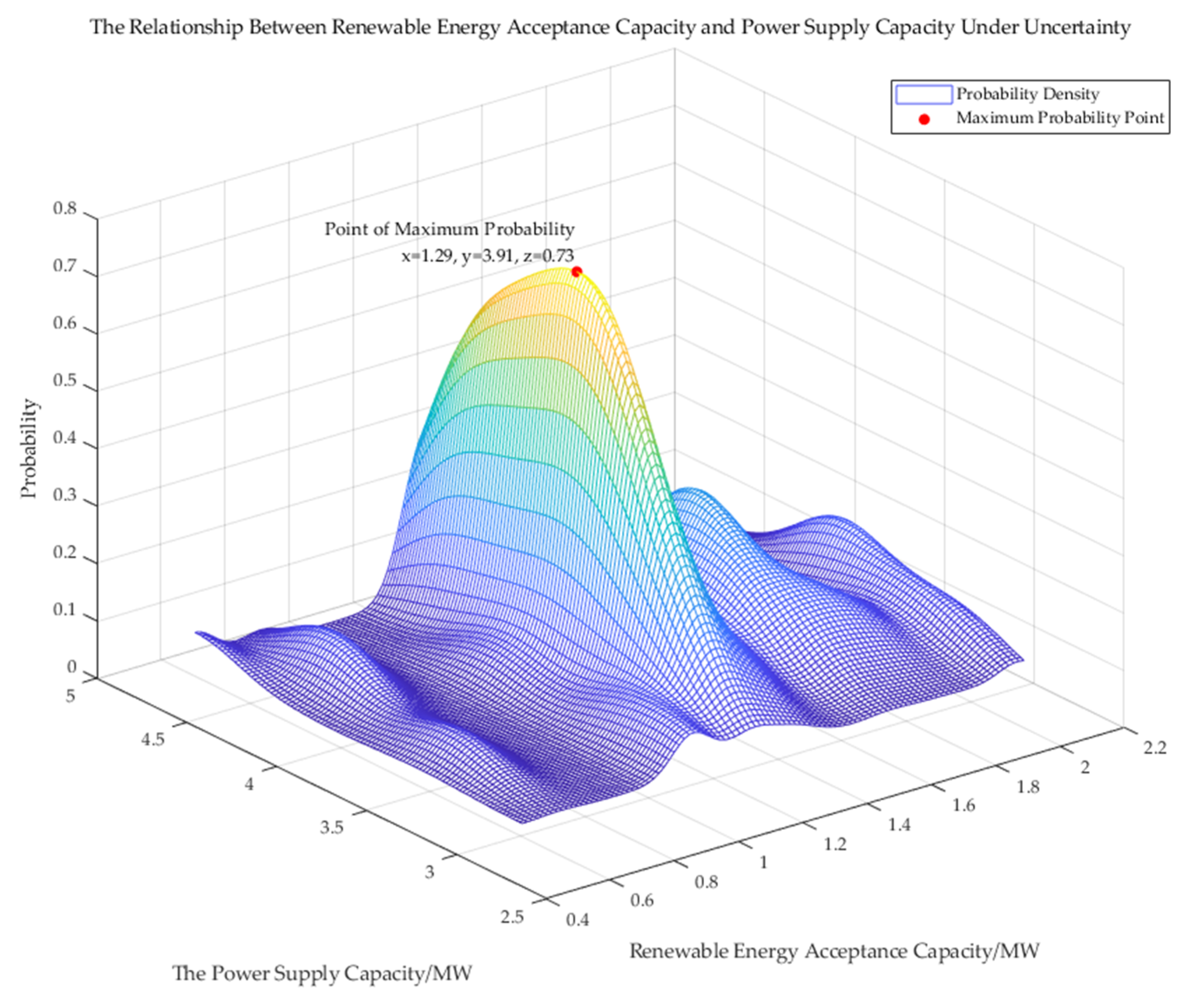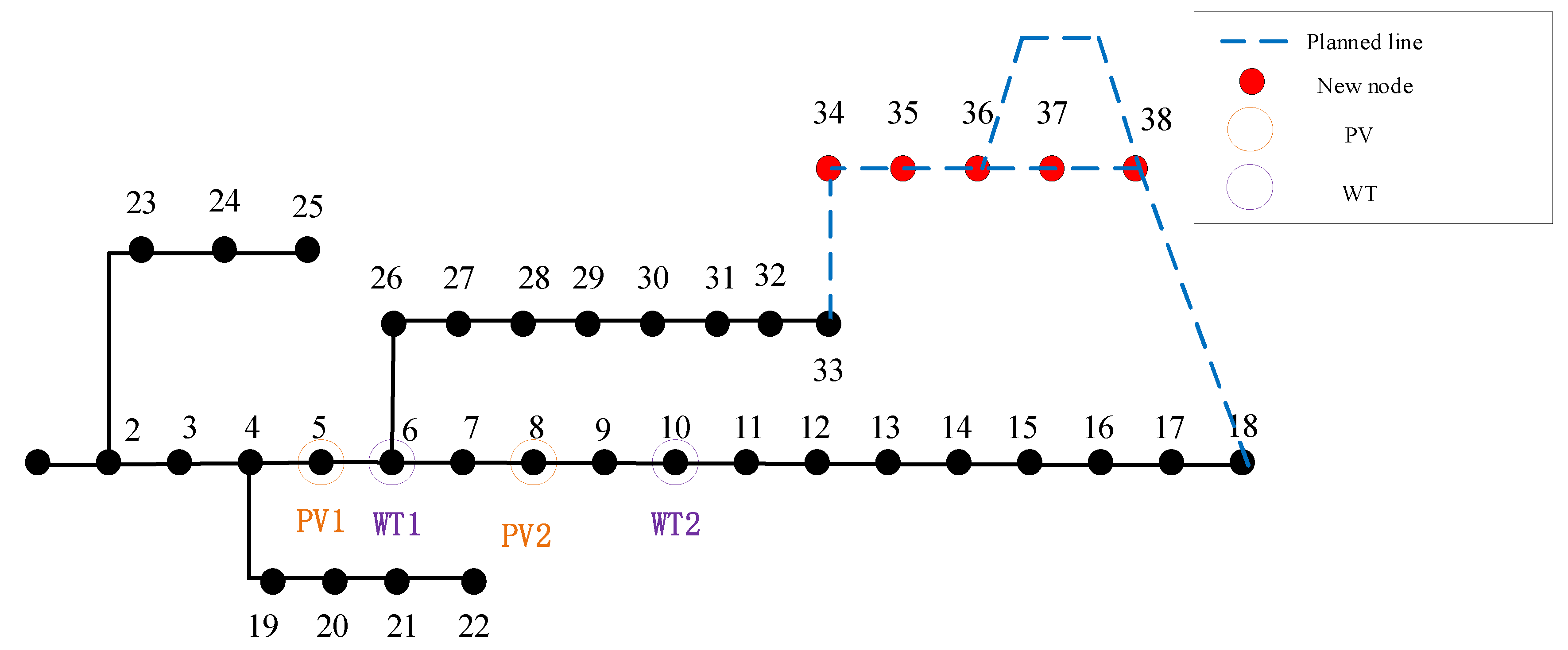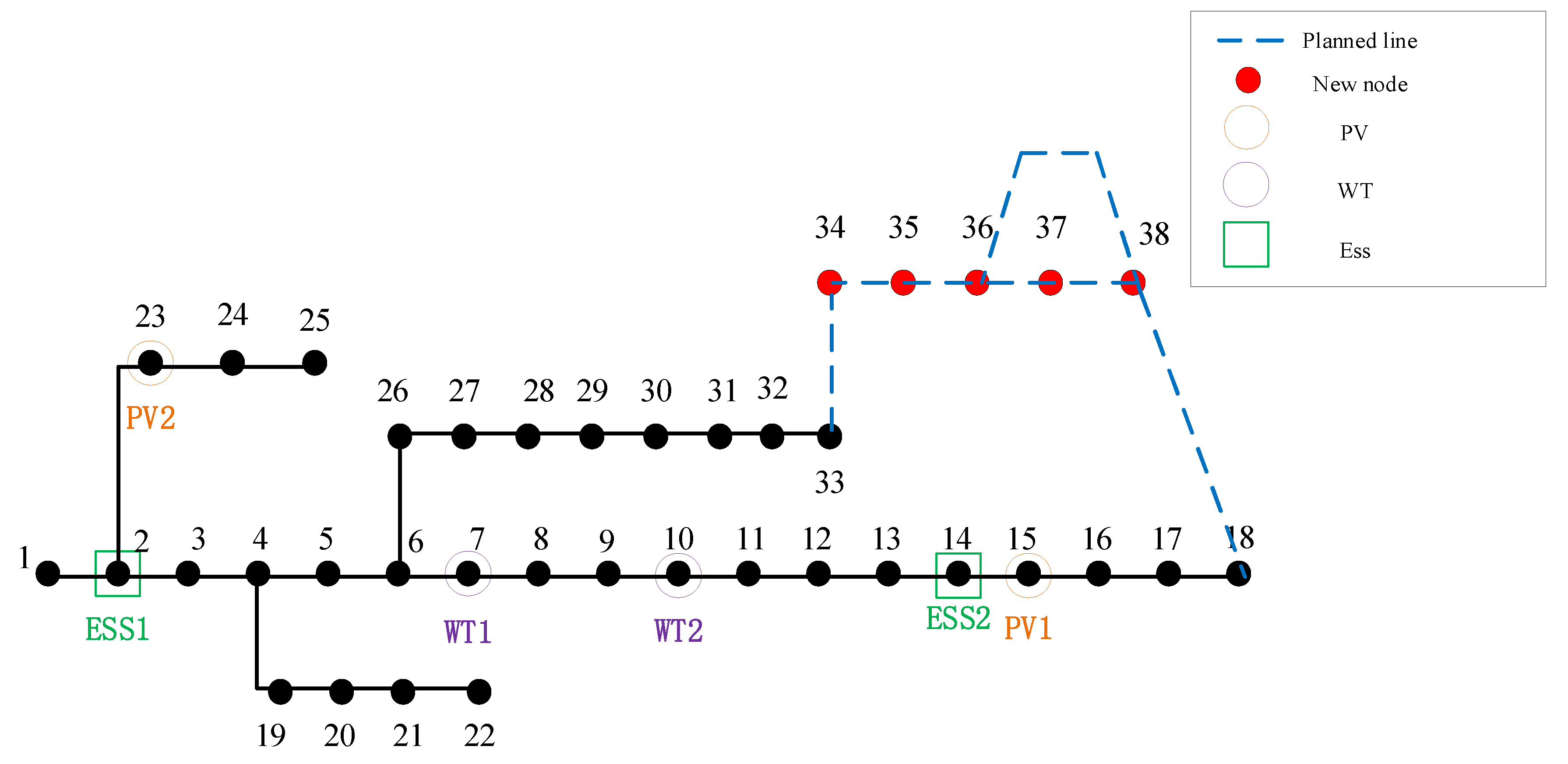5.2.1. Analysis of the Relationship Between Power Supply Capacity and Renewable Energy Acceptance Capacity
Based on the data provided by the upper-level planning layer, which are transmitted to the lower-level for calculation, the distribution network undergoes reconstruction at the lower level. The power supply capacity and the renewable energy acceptance capacity for distributed generation are then calculated using Equations (24) and (25). To validate the impact of the bi-level network and energy storage joint planning and reconstruction strategy model on the power supply capacity and renewable energy acceptance capacity of the distribution network, the following three scenarios are considered:
Scenario 1: Add wind and solar power to the new 38-node distribution network.
Scenario 2: Add energy storage to Scenario 1.
Scenario 3: On the basis of scenario 2, further reconfigure the new 38-node distribution network, incorporating the acceptance of wind, solar, and energy storage systems.
The results of the above scenarios are compared. Scenario 1 is compared with Scenario 2 to explore the impact of adding energy storage on the power supply capacity and renewable energy acceptance capacity of the distribution network. The results of Scenario 2 are then compared with Scenario 3 to investigate whether the reconstruction of the distribution network can improve the two capacities. All three scenarios use distributed generation equipment of the same specifications.
After calculations, the power supply capacity and renewable energy acceptance capacity for Scenario 1 and Scenario 2 are shown in
Figure 4, while the impact of reconstruction on the power supply and renewable energy acceptance capacity of the distribution network is shown in
Figure 5.
From the above
Figure 4 and
Figure 5, it can be observed that there is a clear positive correlation between the power supply capacity and the renewable energy acceptance capacity of distributed generation in the distribution network. In the early stages of distributed generation acceptance, as the renewable energy acceptance capacity increases, the power supply capacity rises rapidly. However, as the renewable energy acceptance capacity continues to grow, the increase in power supply capacity gradually stabilizes and eventually stops growing.
In
Figure 4, Scenario 2 demonstrates a significant improvement in renewable energy acceptance capacity compared to Scenario 1. In Scenario 1, the power supply capacity of the distribution network stops increasing when the renewable energy acceptance capacity reaches approximately 0.35 MW. However, in Scenario 2, with the introduction of an energy storage system, the renewable energy acceptance capacity increases to approximately 0.6 MW. This indicates that the introduction of energy storage systems helps to improve the renewable energy acceptance capacity of the distribution network, enabling it to accept more distributed generation.
Nevertheless, while the addition of energy storage improves renewable energy acceptance capacity, its impact on power supply capacity is relatively limited. This is likely because energy storage primarily functions during load fluctuations and peak demand periods. Although it helps mitigate the uncertainty of distributed generation output, it does not directly increase the maximum power supply capacity of the distribution network. Once the renewable energy acceptance capacity reaches a certain threshold, the contribution of the energy storage system to both capabilities become saturated, and it can no longer effectively improve the system’s maximum power supply capacity, causing the overall curve to plateau.
Figure 5 compares Scenario 3 with Scenario 2. After reconfiguring the distribution network, the power supply capacity is further improved. When the renewable energy acceptance capacity reaches approximately 1.6 MW, the power supply capacity stabilizes. Compared to Scenario 2, Scenario 3 accepts approximately 0.9 MW more distributed generation, with a corresponding increase in power supply capacity of about 0.2 MW. From the growth curves of the two scenarios, Scenario 3’s curve is smoother than that of Scenario 2. This indicates that the reconfigured distribution network can further optimize the network structure, improving both the power supply capacity and renewable energy acceptance capacity of the system.
In summary, without considering uncertainty factors, the introduction of energy storage systems and the reconstruction of the distribution network have led to varying degrees of improvement in the power supply and renewable energy acceptance capacities. In Scenario 2, the introduction of the energy storage system significantly improves the renewable energy acceptance capacity of distributed generation, while the reconstruction strategy in Scenario 3 further optimizes the distribution network structure, improving the power supply capacity. This demonstrates that under the context of substantial distributed generation acceptance, the reasonable optimization of network structures and the application of energy storage systems play an important role in improving the power supply and renewable energy acceptance capacities of the distribution network.
5.2.2. Analysis of the Relationship Between Power Supply Capacity and Renewable Energy Acceptance Capacity Considering the Impact of Uncertainty
Based on the analysis of the results in the previous section, it can be observed that as the renewable energy acceptance capacity increases, the power supply capacity also increases, and then essentially ceases to grow. The relationship between the two satisfies the following equation:
where
a,
b,
c are constants.
represents the power supply capacity, and
represents the renewable energy acceptance capacity.
The impact of uncertainty on the distribution network is further considered based on the results of the previous section. Uncertainty factors are analyzed using Monte Carlo simulation with 5000 samples to minimize the influence of sample randomness. The parameters selected in this section are consistent with those in
Section 5.1. The scenarios chosen for analysis are Scenario 2 and Scenario 3 from
Section 5.2.1, with a confidence level of 0.85 for each constraint, to explore the impact of distribution network reconstruction under uncertainty. The planning costs for the two scenarios are shown in
Section 5.2.3. The relationship between power supply capacity and renewable energy acceptance capacity under the two scenarios is illustrated in
Figure 6 and
Figure 7.
Through the comparative analysis of
Figure 6 and
Figure 7, it can be observed that under the confidence level of 0.85, the power supply capacity of the distribution network exhibits certain fluctuations. The relationship between the two capacities no longer shows a simple one-to-one correspondence but is instead presented in the form of a probability distribution. In this case, different renewable energy acceptance capacities correspond to different power supply capacities and associated probabilities.
In
Figure 6, Scenario 2 before reconstruction shows a maximum probability of 0.63 when renewable energy acceptance is 1.04 MW and power supply is 3.60 MW. This indicates that under conditions of uncertainty, the distribution network in this scenario can operate relatively stably at this point. Although fluctuations exist, the position with the highest probability suggests optimal system stability under these conditions.
In
Figure 7, after reconfiguring and optimizing the network structure, Scenario 3 demonstrates an increase in renewable energy acceptance capacity to 1.29 MW, with a corresponding increase in power supply capacity to 3.91 MW. The maximum probability at this point rises to 0.73. This not only shows that the reconfigured distribution network can accept more distributed generation but also reflects a simultaneous improvement in power supply and renewable energy acceptance capacities. The increased probability further validates the improved reliability of the optimized distribution network in addressing uncertainties.
However, both
Figure 6 and
Figure 7 reveal some non-peak probability points, which reflect significant fluctuations and lower occurrence probabilities for certain combinations of the two capacities at the current confidence level. These low-probability points may represent extreme operating states of the system, which should be avoided in practical planning to reduce potential threats to the safety and stability of the distribution network. Thus, resource allocation can be optimized to improve system operational efficiency and reliability.
5.2.3. Distribution Network Planning Results for the Three Scenarios
After calculations, the DG acceptance nodes for the three scenarios mentioned in
Section 5.2.1 are shown in
Table 2 (the data in parentheses indicate the renewable energy acceptance capacities in MW). The planning costs required for the three scenarios are shown in
Table 3. The investment planning results for Scenarios 2 and 3 under uncertainty are shown in
Table 4. The final planning results for Scenarios 1, 2, and 3 are illustrated in
Figure 8,
Figure 9, and
Figure 10, respectively.
As shown in the figure, the new lines selected in Scenario 1 are lines 33–37, 41, and 42. The new lines selected in Scenario 2 are the same as those in Scenario 1. In Scenario 3, the selected lines are 33–37, 39, and 41.
From an economic perspective, the outage cost in Scenario 1 is approximately 100,000 CNY higher than in Scenario 2. However, the energy storage investment cost, maintenance cost, and network loss cost in Scenario 2 are about 40,000 CNY higher than in Scenario 1, which is likely due to the increased maintenance costs associated with adding energy storage. Despite this, the total cost of Scenario 2 is lower than that of Scenario 1, at 1.5187 million CNY and 1.5919 million CNY, respectively.
At the same time, energy storage can effectively reduce the amount of curtailed photovoltaic and wind energy, improve power quality, and improve supply reliability. Therefore, in terms of outage and curtailment costs, the economic performance of Scenario 2 is better than that of Scenario 1. Hence, under the same 38-node network structure, the scenario that includes energy storage is more suitable for the distribution network.
Through the comparative analysis of
Table 3 and
Table 4, it can be observed that the economic performance of Scenarios 2 and 3 shows significant differences under conditions with and without considering uncertainty factors. Firstly, the total cost of Scenario 2 is 1.5187 million CNY/year without considering uncertainty, but it rises to 1.6258 million CNY/year when uncertainty is taken into account, an increase of 107,100 CNY.
Among the cost components of Scenarios 2 and 3, the energy storage investment cost, maintenance cost, and network loss cost increase from 243,200 CNY/year to 296,700 CNY/year. This significant increase is mainly due to the intensified impact of distributed generation output uncertainty on system operations, leading to higher maintenance needs and network losses. In addition, the curtailment cost for wind and solar energy increases from 40,500 CNY/year to 55,400 CNY/year, indicating that the system struggles to fully utilize the surplus energy from distributed generation under uncertain conditions, resulting in greater resource waste.
The outage cost also rises, from 683,700 CNY/year to 722,400 CNY/year, further reflecting the negative impact of uncertainty on the system’s power supply stability.
In contrast, the total cost of Scenario 3 under conventional conditions is 1.5165 million CNY/year, and it rises to 1.6041 million CNY/year when considering uncertainty, an increase of 87,600 CNY, which is smaller than the increase in Scenario 2. This indicates that Scenario 3 has better economic adaptability when dealing with uncertainty.
The energy storage investment cost, maintenance cost, and network loss cost in Scenario 3 increase from 236,700 CNY/year to 285,400 CNY/year, a rise of 48,700 CNY. This increase is smaller than that of Scenario 2, demonstrating that the reconstruction strategy can more effectively handle the uncertainty brought by distributed generation. In addition, the curtailment cost for wind and solar energy in Scenario 3 rises slightly, from 62,300 CNY/year to 70,200 CNY/year, reflecting superior performance of the distribution network in terms of renewable energy acceptance capacity.
The outage cost increases from 672,100 CNY/year to 703,100 CNY/year, a rise of only 31,000 CNY, further proving the effectiveness of system reconstruction in improving power supply reliability.
Based on the results of this section and
Section 4.2, the relationship curves of the two capacities in Scenario 3 (after reconstruction) and Scenario 2 (before reconstruction) show slight differences under varying conditions. The distribution network in Scenario 3 after reconstruction demonstrates significantly stronger power supply capacity and can accept a larger capacity of distributed generation.
However, economically, the reconfigured distribution network in Scenario 3 can integrate more distributed generation but may lead to higher costs for wind and solar curtailment, investment, maintenance, and network losses. This indicates that by sacrificing some economic performance, the reconfigured distribution network system can improve both the power supply capacity and the renewable energy acceptance capacity of the distribution network.

